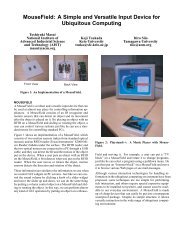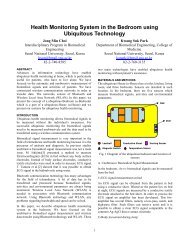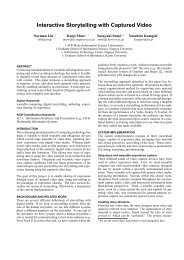Workshops - UbiComp
Workshops - UbiComp
Workshops - UbiComp
- No tags were found...
Create successful ePaper yourself
Turn your PDF publications into a flip-book with our unique Google optimized e-Paper software.
Location-based Social Networking SystemsSocial network services such as MySpace and Facebookallow users to create profiles for themselves, such asuploading a picture and specifying friendship links withother users. Commercial systems for mobile and locationbased social networking services make use of self-reportedlocation (e.g., SocialLight), GPS (e.g., Loopt), andBluetooth (e.g., MobiLuck) in order to leverage locationand context specific social information. All Bluetoothdevices are capable of ‘device-discovery’, which allowsthem to collect information on other Bluetooth deviceswithin 5-10 meters [5]. This information includes a uniqueBluetooth MAC address (BTID), device name, and type.The BlueAware system [5] runs in the background onMIDP2-enabled phones allowing them to record andtimestamp BTIDs in a proximity log and making themavailable to other applications. Researchers have been usingthe BTID patterns to analyze and predict relationshipsbetween users and organizational rhythms [5, 13].Bluscreen is a public advertising system [16] that detectsusers via their Bluetooth devices and has advertising agentsbidding for screen time. Commercial social networkingsystems such as MobiLuck allow mobile phones to detectall nearby Bluetooth devices, ringing or vibrating whenfound, supporting message and photo exchange.WirelessRope also uses Bluetooth and supports contactbetween groups of colleagues at a conference [11]. TheJabberwocky system [12] investigates the “familiarstranger” concept of people who have seen each other inpublic places on multiple occasions but have never met.The Jabberwocky devices log Bluetooth IDs and no centralserver is involved, unlike SocialSense.These systems give us a feel for the possibilities ofconsumer devices in the mobile social networking field. Inaddition, there have been many custom social networkingapplications developed in the wearable computing fieldincluding the infamous lovegety [8], GroupWear [2],Smart-Its Friends [7], nTag, and SpotMe. Particularlyinteresting is the development of systems that incorporategestural language. For example, iBand [9] is a socialnetworking device that creates connections between twousers when they shake hands.Input DevicesEffective interaction technology is also important whenusing a head-mounted display and there have been anumber of gesture-based interfaces developed includingUbi-finger [17], GestureWrist [15], FingeRing [6], andTwiddler (http://www.handykey.com/). There have beenseveral input devices developed in a ring form factor.FingerSleeve [18] has a six-degree-of-freedom tracker, withwhich you have ability to sense all movement, andtranslation and orientation changes. However, it is unsuitedfor our application because of its size and wire connection,and because SocialSense does not require that level oftracking functionality.Figure 1: SocialSense user interface, showing anabbreviated profile (redacted for privacy)PROTOTYPE DEVELOPMENTSocialSense consists of a computer with a Bluetoothadapter that continuously scans for nearby Bluetoothdevices. For each Bluetooth device discovered, it contacts aserver to see if there is a profile associated with the BTIDof the discovered device. If a profile is found, theinformation is downloaded and added to a list of nearbydevices. In addition, if there is a Twitter account associatedwith the profile, the latest status message is retrieved.Devices that are not associated with a profile are alsodisplayed, but the only information that can be displayed isthe name that the device provides (which can sometimes behelpful, such as “Adam Smith’s iPhone”) [10].Software ImplementationThe SocialSense client is written in Java. This decision wasmade early on because Java allows for cross platformdevelopment and deployment. Of particular note is theavailability of a cross-platform specification for usingBluetooth with Java, known as JSR 82(http://jcp.org/en/jsr/detail?id=82).The user interface is simple by design. It displays thedetected users by name and thumbnail image on the righthand side, and the currently selected profile in the center.Log messages are displayed at the bottom of the windowshowing the status of Bluetooth scans and any errorsencountered. Figure 1 shows the user interface.The interface uses white text on a black backgroundbecause on some optical see-through HMDs black istransparent thus avoiding unnecessary occlusion of the realworld.To select a device, the user shifts the selection up and downin the list. Moving the selection off the top or bottom of thelist causes the profile area to be cleared, allowing the userto focus on his or her physical environment instead of theinterface. When a person is selected, that person’sabbreviated profile is displayed, showing their name,picture, phone number and Twitter status. The user can thentoggle between an extended profile that displays theperson’s full bio and the abbreviated profile.77






